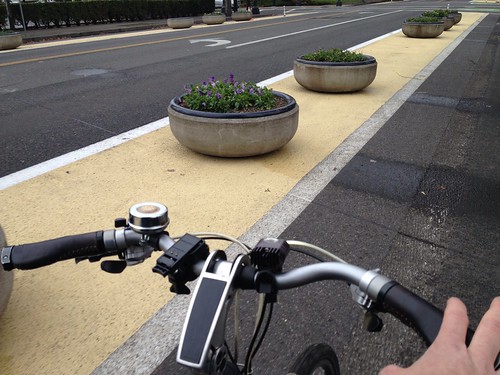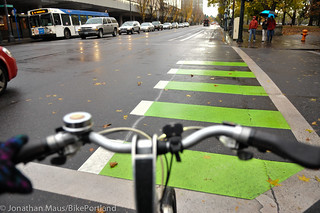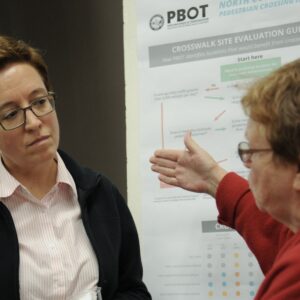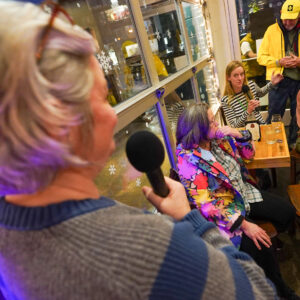As PBOT puts the finishing touches on the (on-street) changes to NE Multnomah in the Lloyd District, a few questions have popped up in my head and in my inbox. What’s with the buffer zone? And why the yellow-ish color? Why isn’t the protected bike lane space painted green?
I put these questions to PBOT recently and they’ve responded with some background that’s worth sharing.
“PBOT looked at earth tones for Multnomah and decided on a color called “beeswax.” This shade of beige contrasts well with wet asphalt and the City of Portland flags that were painted throughout the streetscape.”
— Dan Anderson, PBOT spokesman
First, for the record, the official color of the buffer zone is “beeswax” (not ecru as some of you were calling it). That’s according to PBOT spokesman Dan Anderson. He says PBOT considered various “earth tones” for the project and ultimately settled on the shade of beige known as beeswax because it, “contrasts well with wet asphalt and the City of Portland flags that were painted throughout the streetscape.”
As for why they painted the buffer (and have recently added large potted plants to it), Anderson says it was done to “scale down the streetscape from a wide expanse of pavement meant to move cars to a more approachable street where both people and cars can move safely and efficiently.” In addition to the traffic calming impacts, the paint also lets folks know they shouldn’t drive or park on it.
This is the first painted buffer zone with planters and decorations anywhere in Portland. Where’d the inspiration come from? Why New York City of course — the leaders in reclaiming roadway space. Anderson said PBOT has taken note of New York City’s success using paint to “create spaces out of excess roadway.” “Because the painted buffer is a new edition to our traffic engineering toolkit,” adds Anderson, “we’ll monitor its success and make changes as needed.”
What about the bike lane? Most of the protected lanes in New York City and elsewhere are painted green. There’s even a national program to spur development of protected bike lanes and it’s called the Green Lane Project. So, why aren’t the bike lanes on Multnomah painted green?
Anderson says using green paint is just one tool in their “traffic engineering toolkit” that they use to distinguish bikeways from standard lanes. The bikeways on NE Multnomah are not painted green (except at certain conflict areas), says Anderson, “Because we don’t feel there’s confusion that the space is for people on bikes.”
“The tan-painted buffers with wands and planters and width of the bikeway make it clear that it is not a space for drivers. This distinguishes issues there, for example, from the green lanes on SW Stark and SW Oak.”
There was some initial confusion with people riding in the buffer zone and others not really understanding what was going on. Now with the planters and other features installed, my hunch is that things are working more smoothly (although I won’t be surprised to read a story from the local media about how terrible and confusing the new design is). Anderson said if they start seeing confusion, they’ll consider painting the bikeway.
Are you riding or driving on NE Multnomah? If so, how is it working for you? What are you seeing out there?








Thanks for reading.
BikePortland has served this community with independent community journalism since 2005. We rely on subscriptions from readers like you to survive. Your financial support is vital in keeping this valuable resource alive and well.
Please subscribe today to strengthen and expand our work.
i love it, changed my route so i can ride on it. been thinking of taking a rack and removing some of the leaves, when it rained a bunch the bike lanes where pretty flooded. any word on how they are going to clear debris with the planter boxes?
I ride NE Multnomah twice a day and this has been by biggest concern as well. It’s been alright for a while, but the leaves do pile up here and there and there’s not much of a way to ride around them. I can’t imagine the big truck sweepers snuggling in there, but It probably won’t get really bad again until next autumn.
Another thought:
Cars exiting the Lloyd theater parking lot overwhelmingly tend to idle into the bike lane to prepare for their turn, and the placing of the wands at that location prevent bikes from avoiding them and thus just have to stop and wait for cross traffic to let the car exiting the parking lot in.
This is my biggest concern about how cycle tracks will function with on street parking. Not the narrowness, not the right-hook risk, but car’s sitting in the lane trying to turn onto the street.
Cars will often inch over the sidewalk and into the parking lane so that they may get visibility to see the street and look for gaps. On a street with a normal bike lane, this is no problem, and pedestrians can usually just walk around.
But on a cycle track street, the bikes are behind the parking. When cars inch forward into the parking lane, they are also blocking the cycle track.
Beeswax: I’ll be minding it. (I know, just slap me.)
> although I won’t be surprised to read a story from
> the local media about how terrible and confusing
> the new design is)
I bet it’s KATU and I bet they also mention the price tag. (in absolute terms so as not to reveal how miniscule it actually is)
I rode it, I loved it, I felt sad when it ended in a normal-sized bikelane after MLK/Grand. Yayyy PBOT! I sent my feedback in an email to the Multnomah Main Street project.
I used it until my office moved. When the plans were first announced it all seemed unnecessary, but when I finally used it I felt a sense of calm that was lacking before.
I think it works wonderfully and I don’t find the yellow color in the buffer to be confusing at all. Green is a lane you ride in. You don’t ride on the buffer, therefore it should not be green. Simple.
agree completely. Used it the first time on Sunday.
Yeah. Rode it for the first time in a long time and it made total sense. Like the planters.
I like that I can walk the sidewalks along Multnomah with my four-year-old, without cars passing at 30+ within just a couple feet.
Some of the Portland Flags will be gone by spring. I was watching as cars were coming north to Multnomah from NE 12th. EVERY single automobile drove over the flag as they made the right turn onto NE Multnomah. I watched as over a dozen cars did the same thing.
Add some studded tires and poof…all gone.
Overall though it is a very nice stretch of bikeway.
The hit posts that separated the parking spots from the bike lane up by the movie theater (on the South side of Multnomah, between 15th & 16th?) were removed several weeks ago for construction (along with one of the new yield signs). It’d be really nice if they were put back in (since construction appears to have been completed), as I frequently see cars parked right up against the curb there, rather than in the designated parking zone, completely blocking the bike lane. It only takes one car to park incorrectly, then all the other cars follow suit. Luckily the first car has parked correctly over the last few days, so everyone else has as well (maybe they’re catching on)… but those hit posts would really help. Any idea when they’re going back in?
In addition to the traffic calming impacts,
I agree on the traffic calming but I think diagonal white stripes, as used in other buffer zones, would have a very similar calming affect.
the paint also lets folks know they shouldn’t drive or park on it.
Not so much. What law says I can’t drive or park on “beeswax” painted zones? I can drive on green painted zones (after yielding to bikes, of course). I can’t drive or park on diagonal white stripes or red or yellow curbs. But “beeswax”…where’s the law?
Overall I like the look of Multnomah Street and expect it will work well enough, but PBOT needs to move beyond its many years of experimental bikeway markings and settle on some standards with widespread adoption (see: red paved bike lanes).
Giant Chia Pets growing out of beeswax!
How awesome and interminably progressive an addition is that to PBOT’s full-feeling toolkit?
I rode it recently in the dark and was confused by and large. I wondered on the yield signs, who was supposed to yield. I liked that this would lead to fewer right hooks but it was not clear whether the driver had to yield or the bicyclists. I would imagine that each would assume they had the right of way and squish goes the bicyclist.
The point on the yield signs is a really good one – if you pay attention also to the street markings, it is clear that it is intended for the motor vehicles, but the signs are entirely ambiguous.
Overall a nicer and safer feeling ride, but the leaves are a concern.
Went through the area last week three by bike, and once in a car, then on foot. In NONE of these situations were these bike lanes/buffers useful, safe, or understandable. I circled the area to try them again on one ride, and decided to abandon them as a hazard, as I would the bike lane on SW Broadway.
As a long term serious cyclist, I struggled to even recognize them as being for cycling use. And must say that doing all this without adding more crosswalks is ludicrous. As a pedestrian there it was scary.
I know a lot of work was put into over complicating travel through this area, but I must question why.
the gushing over this facility reminds me of the response to the Broadway cycle track — a facility that is disliked by most who use it.
I won’t use this facility because it is chronically strewn with debris, creates unnecessary conflict in mixing zones, and intensifies right hook risk by hiding cyclist behind a wall of parked cars. And don’t even get me started on the ridiculous buffer zone. As a 30+ year commuter I find his facility to be a complete joke. Its a cheap, unsafe, and amateurish imitation of European cycling facilities.
A buffered bike lane or a cycle track without a wall of parked cars (and random barriers) would have been a vast improvement over this cluster****.
Aren’t a lot of successful northern European cycletracks separated by parked cars, planters, and other physical barriers from motor vehicle traffic? What would you change in the NE Multnomah cycletrack to make it like the European facilities?
This wall of parked cars phenomenon is largely a North American “build it cheap” feature. When barriers exist in europe they often exist as a lip or elevated surface. The dutch also channelize traffic or use signaling in ways that greatly reduce right hook conflict.
Signaling. Without separate signal phases, the “mixing zones” become right-hook nightmares where invisible cyclists “come out of nowhere” and poor, innocent drivers are cleverly lured into running over them.
You would hate Copenhagen and Amsterdam.
Timing the lights for bikes would really improve the ride through Multnomah.
I was concerned about pedestrian crossings in a couple of crosswalks in the middle of the block. Their view was blocked by street trees and I could imagine someone stepping out into my path when they didn’t see a car.
Love the lanes, would still like to see the buses just stop in the car lane with a crosswalk across the bike lane for riders like they have in Copenhagen. Would maybe slow down traffic a little but make it much safer in my opinion.
I have used Multnomah for over 7 years as a daily commuter. I’m going to be looking for a different street now.
1) The leaves in the bike lane are a significant danger to cyclists. This evening riding on Multnomah towards downtown I took the entire car lane for the first time instead, from the lloyd movie theater ,to the Rose quarter.
2) On previous days parked cars on the outside of the buffer zone made it difficult for drivers to know I was in the bike lane. As I approached 2-3 intersections several cars came close to right hooking me.
3) If I have to ride Multnomah in the future there is no question that I’ll skip the bike lane and ride in the car lane where I’m safer.
Oh. You must have been trying to vroom-vroom your way along at upwards of 9mph. If you stick to the optimal maximum of 8mph, everything becomes perfectly safe…
Scorcher!
[/sarcasm]
How about BOM getting out there to clean up the leaves! And will PBOT adjust the signal timing to something like downtown’s 12 MPH? Otherwise a good start on a needed road diet on NE Multnomah.
I haven’t ridden the Multnomah facility.
I was thinking about it, though, the last several times I was bumping over the catch basins on westbound Capitol in Hillsdale. Those catch basins were never brought up to street height when they last repaved. I’d rather have fixed catch basins than beeswax colored buffer zones.
That is, PBOT, take care of the basic stuff, then worry about getting fancy.
Yes, I have submitted requests for fixes on Capitol, at least twice.